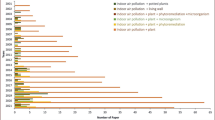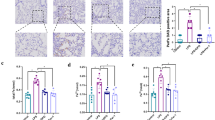Abstract
The impact of PM2.5 on epithelial cells is a pivotal process leading to many lung pathological changes and pulmonary diseases. In addition to PM2.5 direct interaction with epithelia, macrophages that engulf PM2.5 may also influence the function of epithelial cells. However, among the toxic researches of PM2.5, there is a lack of evaluation of direct or indirect exposure model on human bronchial epithelial cell against PM2.5. In this present research, PM2.5-exposed human bronchial epithelial cell line (BEAS-2B) serves as the direct interaction model. By contrast, a PM2.5-stimulated co-culture model of macrophages and epithelial cells based on the transwell system was adopted as indirect stimulation model. By comparing these two models of interaction, we examined the viability of BEAS-2B and mRNA/protein expression profile of oxidative stress and inflammatory response-related transcription factors Nrf2, NF-kB, and according inflammatory indicators such as IL-1, IL-6, and IL-8, with a view to evaluating the effects of different interaction models of PM2.5 on epithelial cell damage in vitro. Our results indicated that under the same doses, the direct stimulation model of PM2.5 could inhibit the viability of BEAS-2B. Furthermore, the indirect stimulation model strengthen inflammation response of epithelia under the higher concentration of PM2.5 and induce epithelia to undergo EMT under the lower concentration of PM2.5. Overall, we have found that macrophage involvement may protect epithelia from PM2.5 cytotoxic effect, while it strengthens the inflammation response and induce epithelia to undergo EMT.







Similar content being viewed by others
Data availability
The datasets used and/or analyzed during the current study are available from the corresponding author on reasonable request.
References
Cho CC, Hsieh WY, Tsai CH, Chen CY, Chang HF, Lin CS (2018) In vitro and in vivo experimental studies of PM2.5 on disease progression. Int J Environ Res Public Health 15:1380
Dagher Z, Garcon G, Billet S, Gosset P, Ledoux F, Courcot D, Aboukais A, Shirali P (2006) Activation of different pathways of apoptosis by air pollution particulate matter (PM2.5) in human epithelial lung cells (L132) in culture. Toxicology 225:12–24
Falcon-Rodriguez CI, Osornio-Vargas AR, Sada-Ovalle I, Segura-Medina P (2016) Aeroparticles, composition, and lung diseases. Front Immunol 7:3
Feng S, Gao D, Liao F, Zhou F, Wang X (2016) The health effects of ambient PM2.5 and potential mechanisms. Ecotoxicol Environ Saf 128:67–74
Jeong S, Park SA, Park I, Kim P, Cho NH, Hyun JW, Hyun YM (2019) PM2.5 exposure in the respiratory system induces distinct inflammatory signaling in the lung and the liver of mice. J Immunol Res 2019:3486841
Kumar P, Kalaiarasan G, Porter AE, Pinna A, Klosowski MM, Demokritou P, Chung KF, Pain C, Arvind DK, Arcucci R, Adcock IM, Dilliway C (2021) An overview of methods of fine and ultrafine particle collection for physicochemical characterisation and toxicity assessments. Sci Total Environ 756:143553
Li Q, Sun J, Chen X, Li S, Wang Y, Xu C, Zhao J, Zhu Z, Tian L (2020) Integrative characterization of fine particulate matter-induced chronic obstructive pulmonary disease in mice. Sci Total Environ 706:135687
Li R, Yang L, Jiang N, Wang F, Zhang P, Zhou R, Zhang J (2020b) Activated macrophages are crucial during acute PM2.5 exposure-induced angiogenesis in lung cancer. Oncol Lett 19:725–734
Techasen A, Namwat N, Loilome W, Bungkanjana P, Khuntikeo N, Puapairoj A, Jearanaikoon P, Saya H, Yongvanit P (2012) Tumor necrosis factor-alpha (TNF-alpha) stimulates the epithelial-mesenchymal transition regulator Snail in cholangiocarcinoma. Med Oncol 29:3083–3091
Tonelli C, Chio IIC, Tuveson DA (2018) Transcriptional regulation by Nrf2. Antioxid Redox Signal 29:1727–1745
Vogel CF, Garcia J, Wu D, Mitchell DC, Zhang Y, Kado NY, Wong P, Trujillo DA, Lollies A, Bennet D, Schenker MB, Mitloehner FM (2012) Activation of inflammatory responses in human U937 macrophages by particulate matter collected from dairy farms: an in vitro expression analysis of pro-inflammatory markers. Environ Health 11:17
Wang Y, Zhong Y, Zhang C, Liao J, Wang G (2020) PM2.5 downregulates MicroRNA-139-5p and induces EMT in bronchiolar epithelium cells by targeting Notch1. J Cancer 11:5758–5767
Xu Z, Ding W, Deng X (2019) PM2.5, fine particulate matter: a novel player in the epithelial-mesenchymal transition? Front Physiol 10:1404
Yang L, Liu G, Lin Z, Wang Y, He H, Liu T, Kamp DW (2016) Pro-inflammatory response and oxidative stress induced by specific components in ambient particulate matter in human bronchial epithelial cells. Environ Toxicol 31:923–936
Yang L, Liu G, Li X, Xia Z, Wang Y, Lin W, Zhang W, Zhang W, Li X (2020) Small GTPase RAB6 deficiency promotes alveolar progenitor cell renewal and attenuates PM2.5-induced lung injury and fibrosis. Cell Death Dis 11:827
Zhao Q, Chen H, Yang T, Rui W, Liu F, Zhang F, Zhao Y, Ding W (2016) Direct effects of airborne PM2.5 exposure on macrophage polarizations. Biochim Biophys Acta 1860:2835–2843
Zhong Y, Liao J, Hu Y, Wang Y, Sun C, Zhang C, Wang G (2019) PM2.5 Upregulates MicroRNA-146a-3p and induces M1 polarization in RAW264.7 cells by targeting sirtuin1. Int J Med Sci 16:384–393
Zhu L, Zhao Q, Yang T, Ding W, Zhao Y (2015) Cellular metabolism and macrophage functional polarization. Int Rev Immunol 34:82–100
Zhu Z, Chen X, Sun J, Li Q, Lian X, Li S, Wang Y, Tian L (2019) Inhibition of nuclear thioredoxin aggregation attenuates PM2.5-induced NF-kappaB activation and pro-inflammatory responses. Free Radic Biol Med 130:206–214
Funding
This study was supported by the National Natural Science Foundation of China (Nos. 81602832, 91643114, and 81973008).
Author information
Authors and Affiliations
Contributions
Yan Wang: conceptualization, data analyses, original draft preparation; Xin Zuo: conceptualization, data analyses, material acquisition, original draft preparation; Zhonghui Zhu: technical consulting, writing — review and editing, supervision; Fuyang Jiang: experimental operation, data analyses; Lin Hou: experimental verification, data analyses; Qiyue Jiang: experimental verification, data analyses; Lin Tian: conceptualization, funding acquisition, writing — review and editing, supervision.
Corresponding author
Ethics declarations
Ethical approval
Not applicable.
Consent to participate
The participants could withdraw from the study at any time without giving any reason.
Consent for publication
Not applicable.
Competing interests
The authors declare no competing interests.
Additional information
Responsible Editor: Lotfi Aleya
Publisher's note
Springer Nature remains neutral with regard to jurisdictional claims in published maps and institutional affiliations.
Rights and permissions
About this article
Cite this article
Wang, Y., Zuo, X., Jiang, F. et al. A comparative study on the model of PM2.5 direct or indirect interaction with bronchial epithelial cells. Environ Sci Pollut Res 29, 41567–41576 (2022). https://doi.org/10.1007/s11356-021-18324-2
Received:
Accepted:
Published:
Issue Date:
DOI: https://doi.org/10.1007/s11356-021-18324-2




